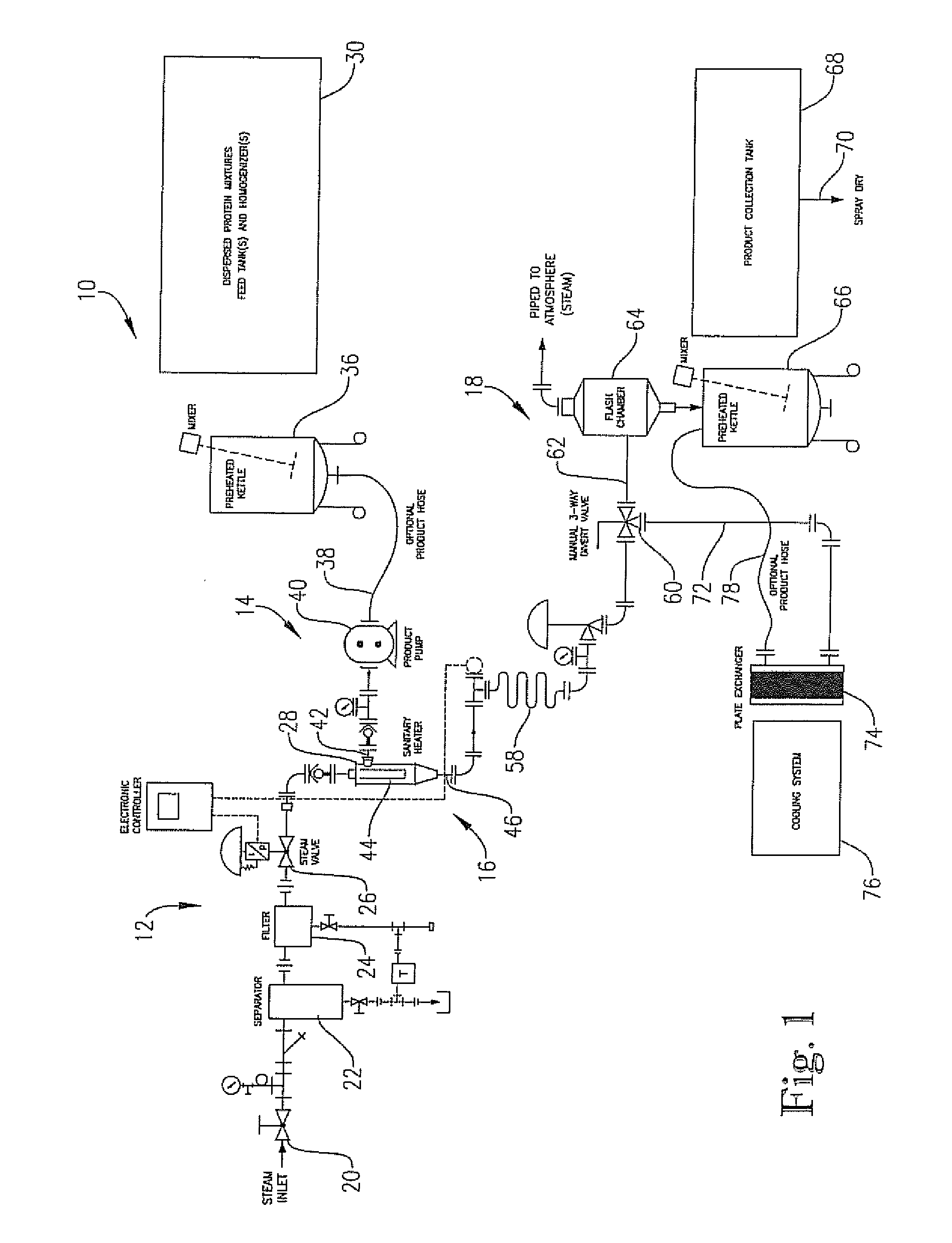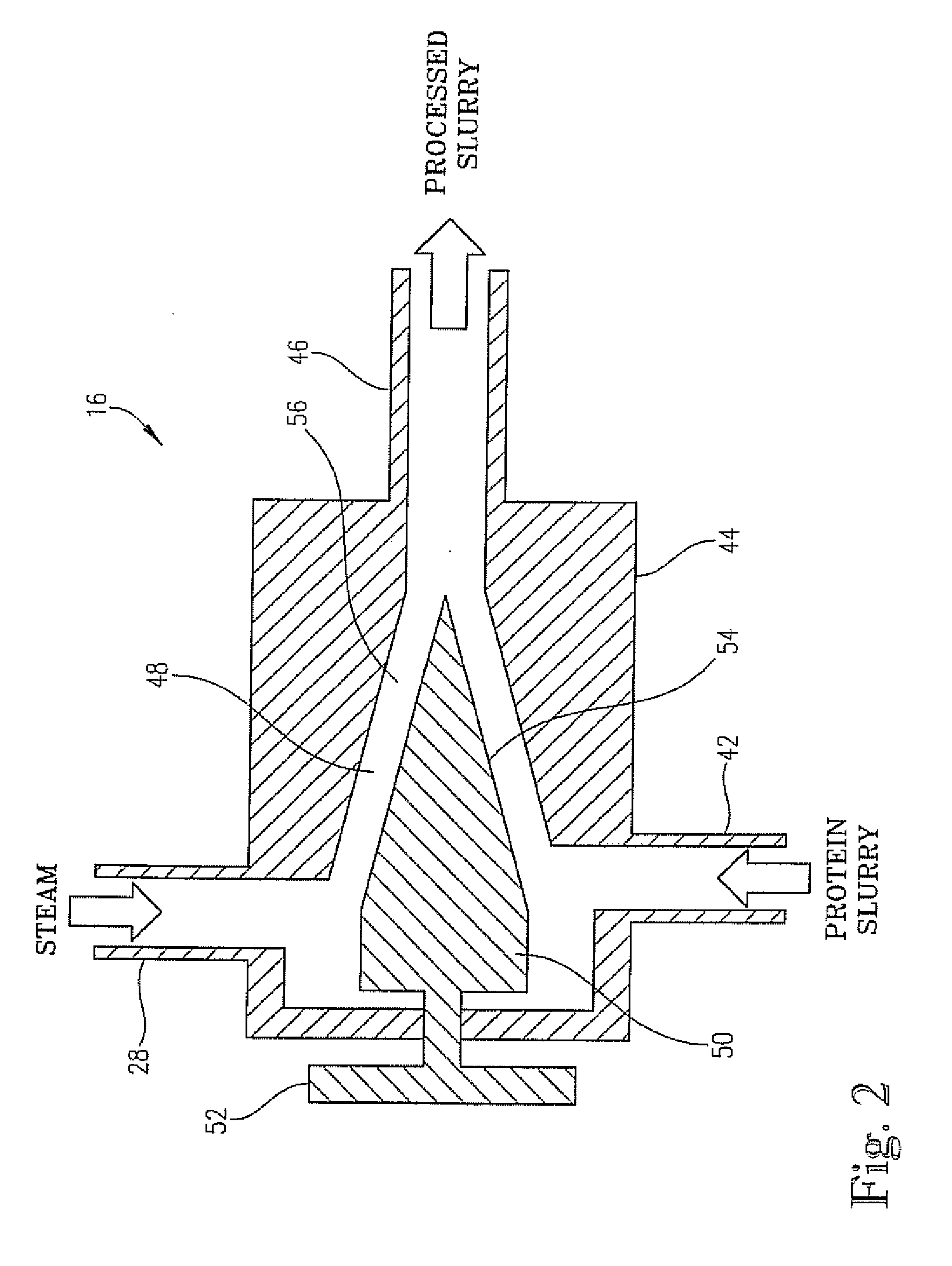Process for preparing hybrid proteins
- Summary
- Abstract
- Description
- Claims
- Application Information
AI Technical Summary
Benefits of technology
Problems solved by technology
Method used
Image
Examples
example 1
[0055]In this example, wheat protein isolate (Arise 5000, MGP Ingredients, Inc.) and soy protein isolate (EX-38, Solae Company) were combined at a ratio of 50:50 on a w / w basis. Slurries were then made with a total solids content of 5% w / w. The mixtures were then homogenized using a Morehouse-Cowles model V-0-01 homogenizer at a speed of about 40-50 Hz until a uniform mixture was obtained. During the course of homogenization, the pH of the mixtures was adjusted to acidic (3-4.5) or basic (8-9.5) using either lactic acid or hydrochloric acid or sodium hydroxide. After homogenization, the mixtures were transferred to a tank and then processed in the jet cooker described above, at a temperature of 250° F. After jet-cooking, the processed mixtures were transferred to a holding tube for 25-35 seconds. After the holding period, the solutions were collected and then spray-dried to yield final dried hybrid protein powders. The moisture content of the final products ranged between 4-8% by we...
example 2
[0061]In this example combined proteins were prepared using wheat protein isolate (Arise 5000, MGP Ingredients, Inc.), blended with soy protein concentrate (Procon 2000, Solae Co.) at a 50:50 and 60:40 w / w ratio. The initial proteins were mixed in water to give 5% w / w slurry, and the liquid mixtures were then processed by homogenization with pH alteration, jet-cooking and holding, as described in Example 1.
[0062]The solubility of the initial proteins and the combined proteins were comparatively tested. The N solubility (between pH 6.5 and 7.5) of the Arise 5000 was about 5% to 3% and that of Procon 2000 was 1% to 1.2%. The values for the combined hybrid proteins processed at acidic pH were between 17% to 22%. In this case, a significant increase in the solubility of the combined protein was observed when compared with both the initial proteins. This clearly shows the synergistic effect of the process disclosed in this invention.
[0063]Additional products were made using 10%, 12.5%, a...
example 3
[0064]In this example combined proteins were prepared using wheat protein isolate (Arise 5000, MGP Ingredients, Inc.), blended with soy protein isolate (Supro 516, Solae Co.) at a 50:50 w / w ratio. The initial proteins were mixed in water to give 5% w / w slurry, and the liquid mixtures were then processed by homogenization with pH alteration, jet-cooking and holding, as described in Example 1.
[0065]The solubility of the initial proteins and the combined proteins were tested. The N solubility (between pH 6.5 and 7.5) of the Arise 5000 was about 5% to 3% and that of Supro 516 was 13% to 21%. And the values for combined proteins of the two processed at acidic pH were between 10.7% to 12% and the ones processed under basic pH were 18% to 22%. This again shows the synergistic effect of the present process.
[0066]It was observed that the emulsification capacity (EC) of the combined protein was significantly altered. The Supro 516 protein by itself, took about 145 ml oil to break the emulsion...
PUM
| Property | Measurement | Unit |
|---|---|---|
| Temperature | aaaaa | aaaaa |
| Temperature | aaaaa | aaaaa |
| Temperature | aaaaa | aaaaa |
Abstract
Description
Claims
Application Information
 Login to View More
Login to View More - R&D
- Intellectual Property
- Life Sciences
- Materials
- Tech Scout
- Unparalleled Data Quality
- Higher Quality Content
- 60% Fewer Hallucinations
Browse by: Latest US Patents, China's latest patents, Technical Efficacy Thesaurus, Application Domain, Technology Topic, Popular Technical Reports.
© 2025 PatSnap. All rights reserved.Legal|Privacy policy|Modern Slavery Act Transparency Statement|Sitemap|About US| Contact US: help@patsnap.com



